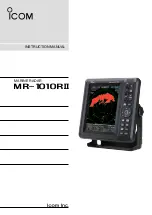
Marine Emergency Signals
The three spoken international emergency signals are:
The distress signal
MAYDAY
is used to indicate that a station is threatened by grave
and imminent danger and requests immediate assistance.
The urgency signal
PAN PAN
is used when the safety of the vessel or person is in
jeopardy. (This signal is properly pronounced pahn pahn.)
The safety signal
SECURITE
is used for messages about the safety of navigation or
important weather warnings. (This signal is properly pronounced see-cure-ee-tay.)
When using an international emergency signal, the appropriate signal is to be spoken
three times prior to the message.
MAYDAY
PAN PAN
SECURITE
Intro
Operation
Customer
Assistance
Warranty
Notice
Main Icons
Secondary Icons
Caution
Warning
Installation
Customer
Assistance
VHF Marine Radio Protocols
Intro
Operation
Customer
Assistance
Warranty
Notice
Main Icons
Secondary Icons
Caution
Warning
Installation
Customer
Assistance
Intro
Operation
Customer
Assistance
Warranty
Notice
Main Icons
Secondary Icons
Caution
Warning
Installation
Customer
Assistance
VHF Marine Radio Protocols
33
Nothing
Comes Close to a Cobra
®
32 English
Emergency Messages and
Distress Procedure
Emergency Messages and
Distress Procedure
Emergency Messages and Distress Procedure
•
The ability to summon assistance in an emergency is the primary reason to have a VHF
marine radio. The marine environment can be unforgiving, and what may initially be a
minor problem can rapidly develop into a situation beyond your control.
The Coast Guard monitors Channel 16, responds to all distress calls, and coordinates
all search and rescue efforts. Depending on the availability of other capable vessels or
commercial assistance operators in your vicinity, Coast Guard or Coast Guard Auxiliary
craft may be dispatched.
In any event, communicate with the Coast Guard as soon as you experience difficulties
and before your situation becomes an emergency. Use the emergency message
procedures only after your situation has become grave or you are faced with a sudden
danger threatening life or property and requiring immediate help. Use Channel 16 to
communicate your emergency message. Make sure you transmit on high power.
If you are merely out of gas, do not send an emergency message. Drop your anchor
and call a friend or marina to bring the fuel you need or to give you a tow.
If You Hear a Distress Call
You must give any message beginning with one of these signals priority over any
other messages. ALL stations MUST remain silent on Channel 16 for the duration of
the emergency unless the message relates directly to the emergency.
If you hear a distress message from a vessel, stand by your radio. If it is not
answered, YOU should answer. If the distressed vessel is not nearby, wait a short
time for others who may be closer to acknowledge. Even if you cannot render direct
assistance, you may be in a position to relay the message.
Marine Distress Procedure
Speak slowly — clearly — calmly.
1.
Make sure your radio is On.
2.
Select Channel 16.
3. Press Talk button and say:
“MAYDAY — MAYDAY — MAYDAY.”
(Or “PAN PAN— PAN PAN— PAN PAN,”
or “SECURITE — SECURITE — SECURITE.”)
4. Say:
“THIS IS [your vessel name or call sign],” repeated three (3) times.
5. Say:
“MAYDAY (or “PAN PAN” or “SECURITE”)
[your vessel name or call sign].
6. Tell where you are:
(what navigational aids or landmarks are nearby).
7.
State the nature of your distress.
8.
State the kind of assistance needed.
9.
Give number of persons aboard and conditions of any injured.
10.
Estimate present seaworthiness of your vessel.
11.
Briefly describe your vessel (length, type, color, hull).
12. Say:
“I WILL BE LISTENING ON CHANNEL 16.”
13. End message by saying:
“THIS IS [your vessel name or call sign]. OVER.”
14.
Release
Talk
button and listen. Someone should answer.
If not, repeat the call, beginning at step 3 above.
Keep the radio nearby. Even after your message has been received, the Coast Guard can
find you more quickly if you can transmit a signal for a rescue boat to hone in on.













































